Amid a lush botanical garden, a group of plants stood out with their sparkling leaves that seemed to reflect the sun’s rays–like verdant diamonds. Yep, they were plants with shiny leaves, one of the most loved divas in the plant world that kept stealing the spotlight with their glamorous foliage! Some of them not only produce this natural ‘wax-coating’ in their foliage, but also in their fruits, blossoms, and stems. Let’s discover these attention-grabbing plants with their glossy foliage that makes you can’t help but be drawn to their radiance glow!
Table of Contents
Outdoor Plants with Waxy Leaves
Dwarf Southern Magnolia (Magnolia grandiflora ‘Little Gem’)

Flourishing Zones: 6 to 8
Estimated Size: 20 feet (6 meters) or more
The shining dark green foliage and fragrant, creamy-white blossoms of the dwarf southern magnolia are perfect for those who love small to medium-sized shrubs and are living in colder areas. You can take advantage of regular pruning to keep them compact-sized, but in general, this plant is a slow-grower, meaning pruning may not be needed during the first stages of their growth.
Magnolia is also listed in our flowers that have star-shaped flowers.
Chinese Fringe Flower (Loropetalum chinense)
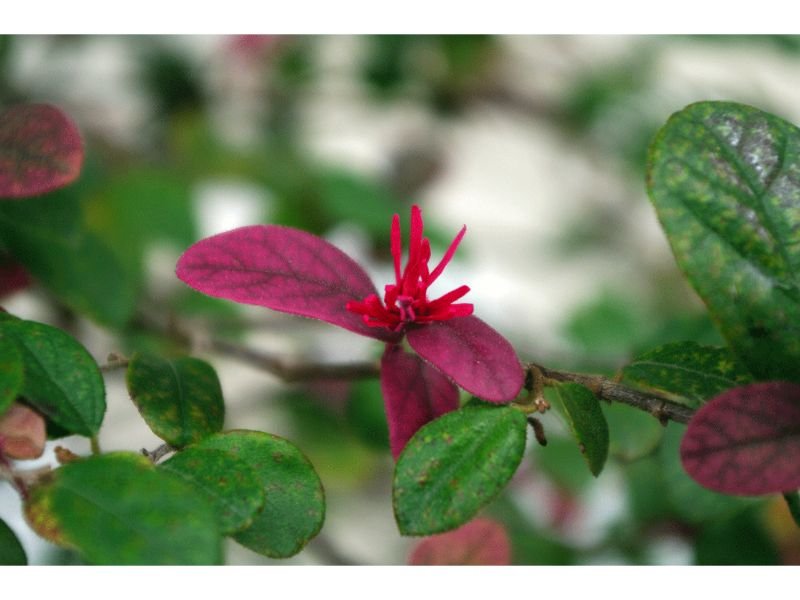
Flourishing Zones: 7 to 9
Estimated Size: 5 to 10 feet (1.5 to 3 meters) or more
Chinese fringe flower is a plant with shiny purple leaves and burgundy or reddish-magenta blossoms that tolerates almost any type of soil. They originate from China, but spread as far as Taiwan, Japan, and Thailand, and prefer to thrive in shady areas with an addition of 6 to 8 hours of direct sunlight daily. A plus value to add, the Chinese fringe flower is generally easy when comes to maintenance.
Common Holly (Ilex aquifolium)

Flourishing Zones: 7 to 9
Estimated Size: 5 to 10 feet (1.5 meters to 3 meters) or more
A symbol of Christmas traditions among Christians, the common holly has numerous cultivars with different colors and sizes to choose from. The plant with shiny green leaves produces berry-like fruits that range in color from red to orange and is also a tasty snack for pollinators and small aves such as hummingbirds. Identical to the dwarf southern magnolia, the common holly is a slow-grower that can take years to reach its mature stage.
Wax-leaf Privet (Ligustrum japonicum)
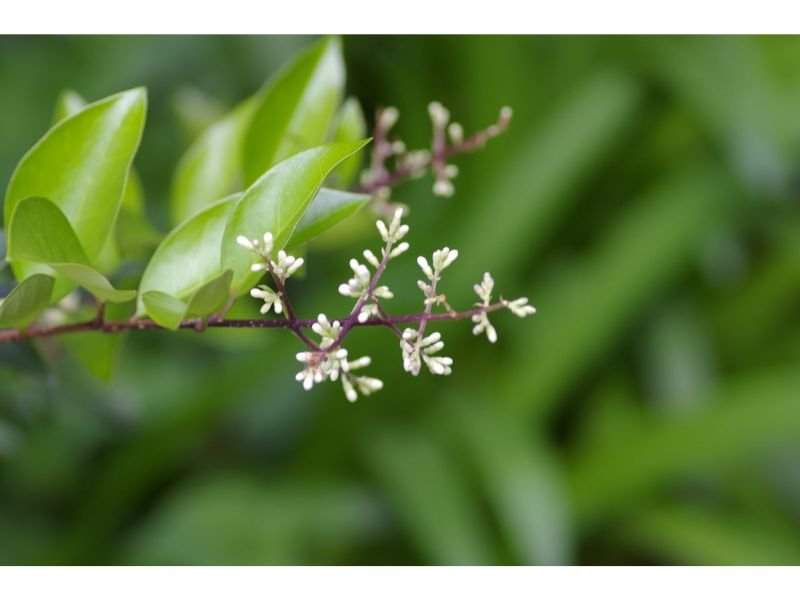
Flourishing Zones: 7 to 10
Estimated Size: 5 to 8 feet (1.5 to 2.4 meters) or more
Not only is this plant with shiny leaves blessed with striking foliage, but the wax-leaf privet also produces clusters of small, creamy-white blossoms that create a spectacular view in spring. This plant tolerates broad soil types but prefers to be in alkaline soil instead of acidic. The wax-leaf privet needs at least 6 to 8 hours of bright sunlight to grow.
Bird’s Nest Fern (Asplenium nidus)
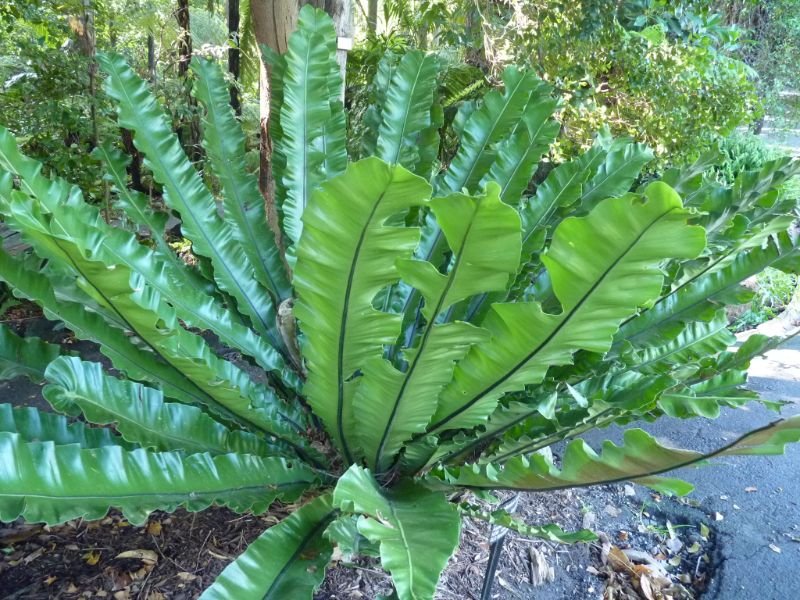
Flourishing Zones: 11 to 12
Estimated Size: 3 to 5 feet (0.9 to 1.5 meters)
Looking for a perennial tropical plant with shiny leaves that stays compact? The gorgeous bird’s nest fern is here to answer your thirst. They tolerate both outdoor and indoor areas but instead are in dappled or shady areas all day. In the wild, bird’s nest fern is epiphytic, meaning they thrive on another plant without being parasitic. Their tender glossy foliage is edible and is often used to treat labor pains and fever.
Painter’s Palette (Anthurium andraeanum)
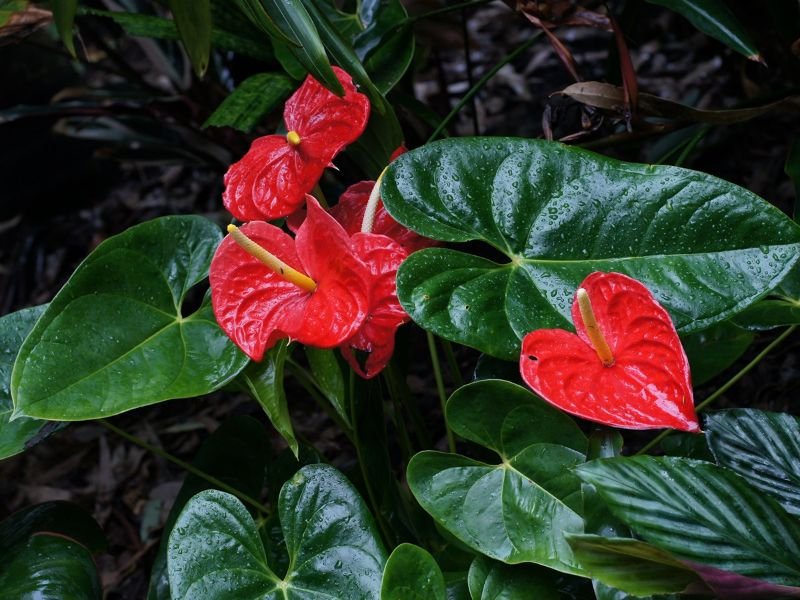
Flourishing Zones: 10 to 12
Estimated Size: 16 to 18 inches (40 to 45 centimeters)
You might get a little bit surprised when you see the painter’s palette at our recommended outdoor plants with shiny leaves. Although many people include this stunning aroid as a part of their indoor plant collection, they also can thrive just well in outdoor spaces–as long as all the growing requirements are met. Another reason to thrive them outdoors is that this plant is mildly poisonous, with calcium oxalate crystals that are toxic and irritated if ingested.
Indoor Plants with Shiny Foliage
Rubber Plant (Ficus elastica)

Flourishing Zones: 9 o 11
Estimated Size: 5 to 10 feet (1.5 to 3 meters) or more
Be cautious when thriving rubber plants indoors as this plant is not children and pet-friendly due to its sap that contains latex. But thanks to their ease of maintenance and fantastic bright and oval-shaped foliage, rubber plants remain a popular choice for indoor plant enthusiasts. From milky white, lime green, and reddish-pink, to deep dark purple, you can pick a rubber plant variation that meets your gardening style and color.
Raven ZZ Plant (Zamioculcas Zamiifolia ‘Raven’)
Flourishing Zones: 9 to 10
Estimated Size: 3 feet (0.90 meters)
As dark and shiny as a raven’s feather, the mysterious raven ZZ plant is the best choice for those who’d like to incorporate that fantasy atmosphere into their indoor garden. To make this plant with shiny purple leaves stay deep dark purple, ensure the plant receives its amount of daily indirect light intake. Identical to their aroid counterparts, raven ZZ plants love some moisture in their soil.
Jade Plant (Crassula ovata)
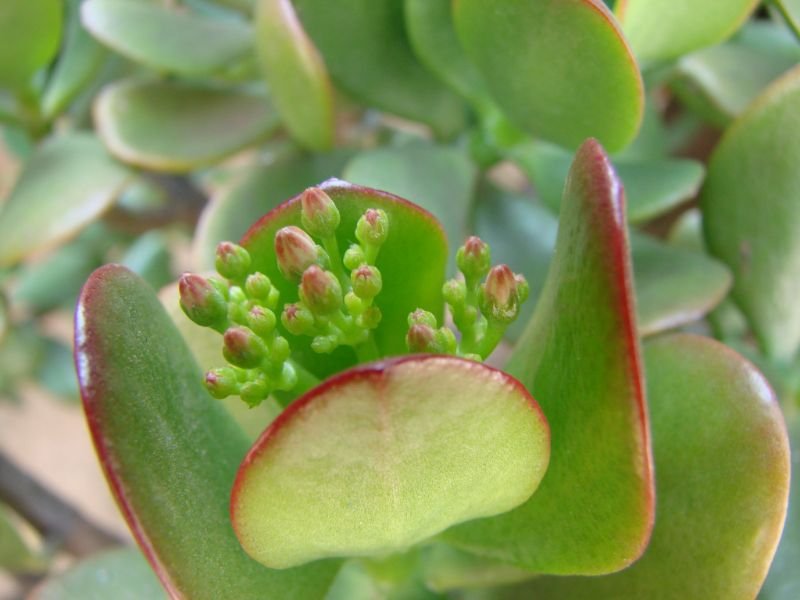
Flourishing Zones: 9 to 11
Estimated Size: 5 to 6 feet (1.5 to 1.8 meters)
If adding a perennial indoor succulent plant with shiny leaves is on your to-do list, you should try growing the charming jade plant. They have lush, dark green, yellowish-green, or burgundy foliage that creates a pleasing contrast with their cluster of tiny, star-shaped white blossoms. They prefer to be in bright areas but will do just fine in shady, darker environments.
Devil’s Ivy (Epipremnum aureum)
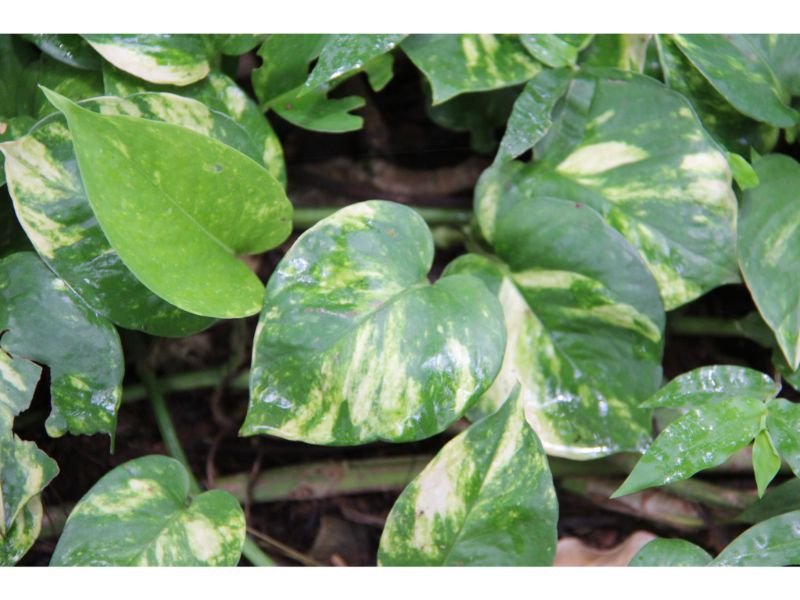
Flourishing Zones: 10 to 12
Estimated Size: 3 to 20 feet (0.9 to 6 meters) or more
Also known as pothos or golden pothos, this vining and creeping aroid got its nickname because of how difficult it is to kill this plant in the wild. Devil’s ivy is a true friend for indoor gardens, as they thrive only in shady areas or areas with dappled sunlight. They are a perfect plant for beginners that keeps thriving even with little care.
Peace Lily (Spathiphyllum)
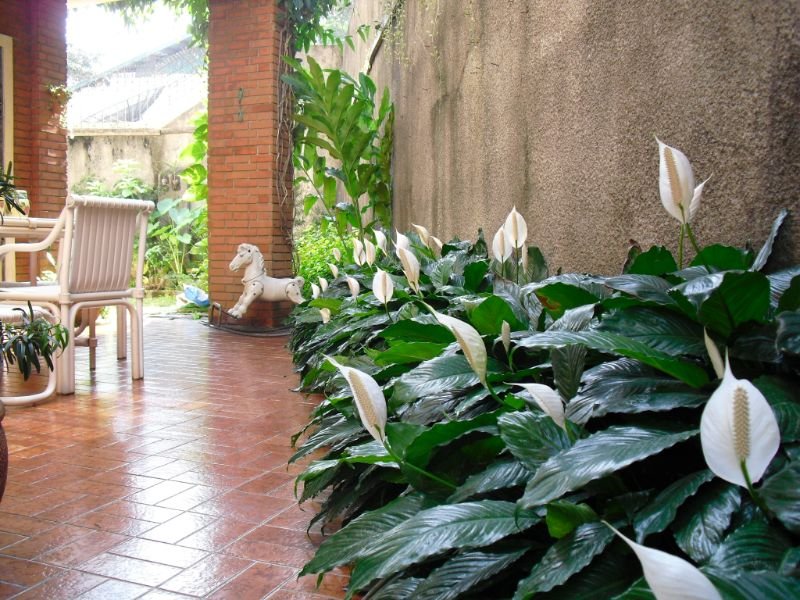
Flourishing Zones: 9 to 11
Estimated Size: 1 to 4 feet (0.3 to 1.2 meters)
As the name indicates, in the language of flowers peace lily is the major representation of peace and hope. It produces pure white spathe with greenish-yellow spadix that blooms from February to September and stays all year round. What’s unique about this plant with shiny leaves is that it’s among the few plants that tolerate and will grow under low-light areas.
Purple Passion Plant (Gynura aurantiaca)
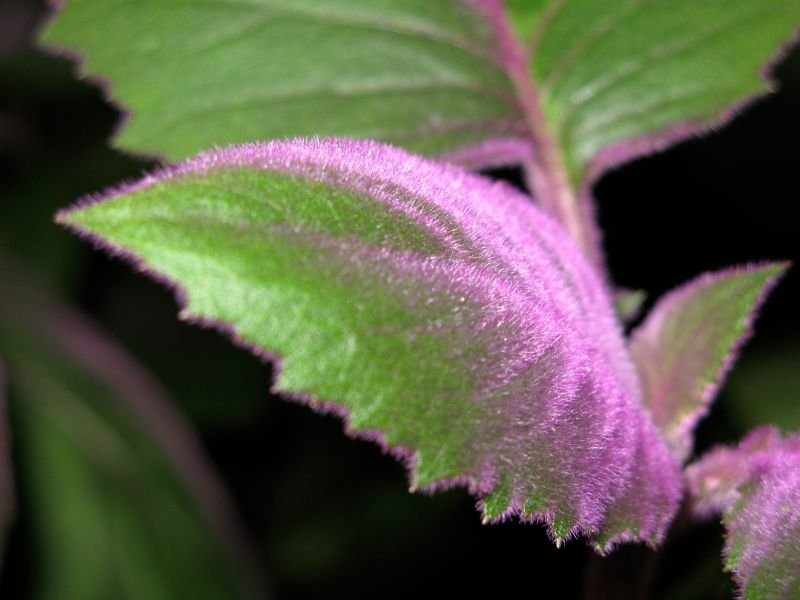
Flourishing Zones: 10 to 12
Estimated Size: 1 to 2 feet (0.3 to 0.6 meters)
The purple passion plant is an indoor houseplant that is almost impossible to not fall in love with. This plant with shiny leaves also produces dark purple or lavender leaves that have a smooth and velvety feel. They don’t have a soil preference but are prone to common pests like spider mites and aphids. Even so, purple passion plants tolerate dry soil and are relatively easy to grow.
What Are Waxy Leaves and Why Do Some Plants Have Them?
The waxy or glossy appearance and texture we find in plants is due to the presence of thin layers called cuticle–which sometimes also cover the fruits, stems, and flowers. Cuticle is a water-resistant layer that acts as a protective barrier for the plant, preventing excess water loss from evaporation, and protecting the plant from damages such as UV rays, insects, and harsh environmental stressors. These thin layers not only make the plant with shiny leaves more attractive but also acts as their natural defense mechanism.
Do Plants with Shiny Leaves Need to be Watered More Often?
Plants with glossy foliage don’t necessarily need to be watered more often than plants with non-shiny leaves. However, watering requirements for each plant are different, depending on its species, climate, environmental conditions, and soil type, so it’s best to do more deep research about each plant and its watering needs.
Wrapping Up
Plants with shiny leaves are not just about looks, they also have a unique defense mechanism against stressors from the outside world. Often easy to care for and can survive in a wide variety of environments, you surely could enhance the beauty of your indoor or outdoor surroundings with these gleaming plants.

New author in the hood. Loves gardening and flowers are my spirit animals (yes I know they are not animals but I insist). I will be covering most of the flowers’ topics here and occasionally random though as well.






